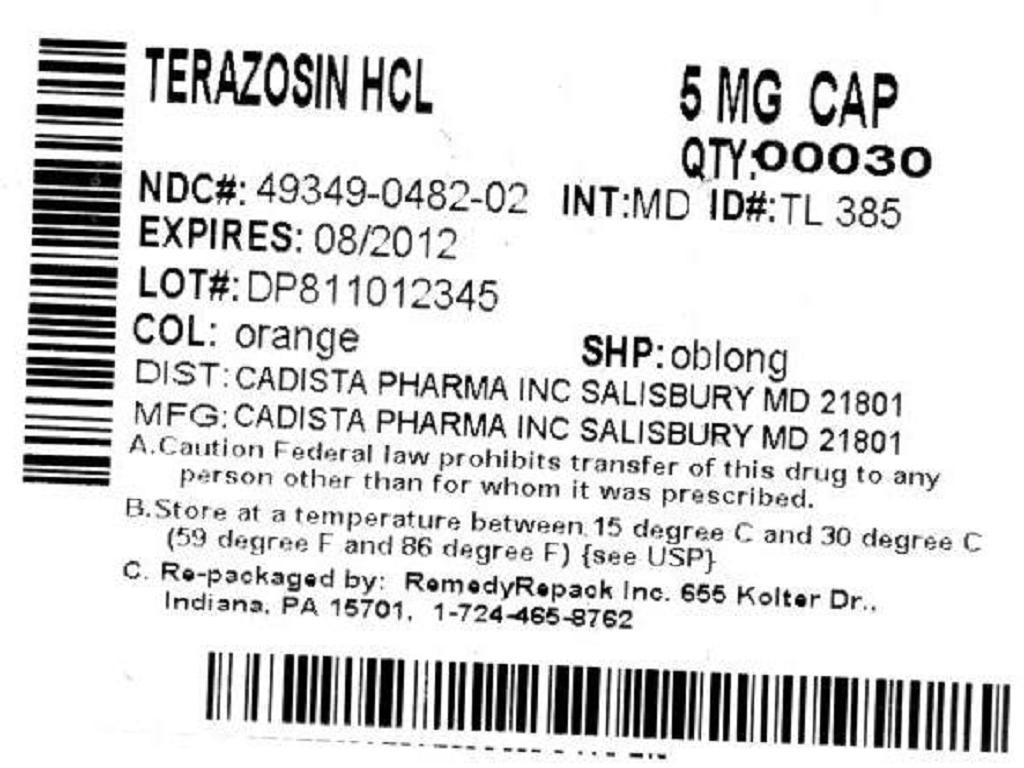Terazosin Hydrochloride
FULL PRESCRIBING INFORMATION: CONTENTS*
- TERAZOSIN HYDROCHLORIDE DESCRIPTION
- CLINICAL PHARMACOLOGY
- PHARMACODYNAMICS
- PHARMACOKINETICS
- INDICATIONS & USAGE
- TERAZOSIN HYDROCHLORIDE CONTRAINDICATIONS
- WARNINGS
- PRECAUTIONS
- INFORMATION FOR PATIENTS
- LABORATORY TESTS
- DRUG INTERACTIONS
- CARCINOGENESIS & MUTAGENESIS & IMPAIRMENT OF FERTILITY
- PREGNANCY
- NURSING MOTHERS
- PEDIATRIC USE
- TERAZOSIN HYDROCHLORIDE ADVERSE REACTIONS
- OVERDOSAGE
- DOSAGE & ADMINISTRATION
- HOW SUPPLIED
- STORAGE AND HANDLING
- SPL PATIENT PACKAGE INSERT
- PACKAGE LABEL.PRINCIPAL DISPLAY PANEL SECTION
FULL PRESCRIBING INFORMATION
TERAZOSIN HYDROCHLORIDE DESCRIPTION

CLINICAL PHARMACOLOGY
PHARMACODYNAMICS
Benign Prostatic Hyperplasia (BPH)**



*****
Hypertension
PHARMACOKINETICS
INDICATIONS & USAGE
TERAZOSIN HYDROCHLORIDE CONTRAINDICATIONS
WARNINGS
Syncope and "First-Dose" EffectTerazosin hydrochloride capsules, like other alpha-adrenergic blocking agents, can cause marked lowering of blood pressure, especially postural hypotension, and syncope in association with the first dose or first few days of therapy. A similar effect can be anticipated if therapy is interrupted for several days and then restarted. Syncope has also been reported with other alpha-adrenergic blocking agents in association with rapid dosage increases or the introduction of another antihypertensive drug. Syncope is believed to be due to an excessive postural hypotensive effect, although occasionally the syncopal episode has been preceded by a bout of severe supraventricular tachycardia with heart rates of 120 to 160 beats per minute. Additionally, the possibility of the contribution of hemodilution to the symptoms of postural hypotension should be considered.
To decrease the likelihood of syncope or excessive hypotension, treatment should always be initiated with a 1 mg dose of terazosin, given at bedtime. The 2 mg, 5 mg and 10 mg capsules are not indicated as initial therapy. Dosage should then be increased slowly, according to recommendations in the Dosage and Administration section and additional antihypertensive agents should be added with caution. The patient should be cautioned to avoid situations, such as driving or hazardous tasks, where injury could result should syncope occur during initiation of therapy.
CLINICAL PHARMACOLOGY
If syncope occurs, the patient should be placed in a recumbent position and treated supportively as necessary. There is evidence that the orthostatic effect of terazosin is greater, even in chronic use, shortly after dosing. The risk of the events is greatest during the initial seven days of treatment, but continues at all time intervals.
Priapism
PRECAUTIONS: Information for Patients
PRECAUTIONS
GeneralProstatic Cancer
Intraoperative Floppy Iris Syndrome (IFIS)
Orthostatic Hypotension
WARNINGS
INFORMATION FOR PATIENTS
Patient Package InsertLABORATORY TESTS
DRUG INTERACTIONS
Use with Other Drugs
DOSAGE AND ADMINISTRATION
CARCINOGENESIS & MUTAGENESIS & IMPAIRMENT OF FERTILITY
PREGNANCY
Teratogenic EffectsPregnancy Category C
Nonteratogenic Effects
NURSING MOTHERS
PEDIATRIC USE
TERAZOSIN HYDROCHLORIDE ADVERSE REACTIONS
Benign Prostatic HyperplasiaPRECAUTIONS
**
Hypertension
**
Post-Marketing Experience
PRECAUTIONS
OVERDOSAGE
DOSAGE & ADMINISTRATION
Benign Prostatic Hyperplasia
Initial Dose
Subsequent Doses
Use With Other Drugs
PRECAUTIONS
Hypertension
Initial Dose
Subsequent Doses
Use With Other Drugs
HOW SUPPLIED
STORAGE AND HANDLING
SPL PATIENT PACKAGE INSERT
-
● a weak or interrupted stream when urinating
-
● a feeling that you cannot empty your bladder completely
-
● a feeling of delay when you start to urinate
-
● a need to urinate often, especially at night, or
-
● a feeling that you must urinate right away.
-
● Program of monitoring or "Watchful Waiting". Some men have an enlarged prostate gland, but no symptoms, or symptoms that are not bothersome. If this applies, you and your doctor may decide on a program of monitoring including regular checkups, instead of medication or surgery.
-
● Medication. There are different kinds of medication used to treat BPH. Your doctor has prescribed terazosin hydrochloride for you. See "What Terazosin Hydrochloride Does to Treat BPH" below.
-
● Surgery. Some patients may need surgery. Your doctor can describe several different surgical procedures to treat BPH. Which procedure is best depends on your symptoms and medical condition.
-
● Terazosin hydrochloride helps relieve the symptoms of BPH. It does NOT change the size of the prostate, which may continue to grow. However, a larger prostate does not necessarily cause more or worse symptoms.
-
● If terazosin hydrochloride is helping you, you should notice an effect on your particular symptoms in 2 to 4 weeks of starting to take the medication.
-
● Even though you take terazosin hydrochloride and it may help you, terazosin hydrochloride may not prevent the need for surgery in the future.
-
● You should see an effect on your symptoms in 2 to 4 weeks. So, you will need to continue seeing your doctor to check your progress regarding your BPH and to monitor your blood pressure in addition to your other regular check-ups.
-
● Your doctor has prescribed terazosin hydrochloride for your BPH and not for prostate cancer. However, a man can have BPH and prostate cancer at the same time. Doctors usually recommend that men be checked for prostate cancer once a year when they turn 50 (or 40 if a family member has had prostate cancer). These checks should continue even if you are taking terazosin hydrochloride. Terazosin hydrochloride is not a treatment for prostate cancer.
-
● About Prostate Specific Antigen (PSA). Your doctor may have done a blood test called PSA. Your doctor is aware that terazosin hydrochloride does not affect PSA levels. You may want to ask your doctor more about this if you have had a PSA test done.
-
● You will start with a 1 mg dose of terazosin hydrochloride. Then the dose will be increased as your body gets used to the effect of the medication.
-
● Other side effects you could have while taking terazosin hydrochloride include drowsiness, blurred or hazy vision, nausea, or "puffiness" of the feet or hands. Discuss any unexpected effects you notice with your doctor.
PACKAGE LABEL.PRINCIPAL DISPLAY PANEL SECTION


Terazosin HydrochlorideTerazosin Hydrochloride CAPSULE
| |||||||||||||||||||||||||||||||||||||||||||||||||||||||||||||
PLEASE, BE CAREFUL!
Be sure to consult your doctor before taking any medication!